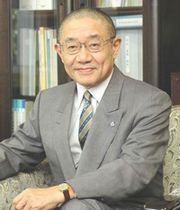|

President
of Nagasaki University
Hiroshi
Saito
M.D., Ph.D.
President's Profile
|
Late Health Effects from Radiation: Knowledge gained from 60 years' experience
in Japan
Opening Remarks
Professor Hiroshi Saito, President of Nagasaki University
Exactly sixty years have passed since unforgettable
days for Hiroshima and Nagasaki. At 11:02 a.m. on August 9, 1945, the explosion
of the second atomic bomb almost completely devastated Nagasaki. The ferocious
heat and blast indiscriminately slaughtered its inhabitants. More than
75000 people were killed and 70000 injured. Those who managed to survive
to the present days still continue to experience and suffer from late health
and mental effects of radiation exposure.
Nagasaki Medical University, nowadays Nagasaki
University School of Medicine, is the only one medical university in the
world that had been completely destroyed by the atomic bombing with about
900 staff members and students instantly killed. During those tragic days,
survived medical staff and students made a tremendous effort to rescue
the survivors in spite of deficient medical facilities and poor knowledge
about acute radiation syndrome. After the ending of World War II, our university
was reconstructed and the Atomic Bomb Disease Institute was newly established
in 1963 to clarify the late effects of radiation exposure and to take an
initiative of medical care of Atomic Bomb survivors. Furthermore, as one
of the WHO Collaborating Centers, we have been contributing to the medical
care of radiation-exposed victims in the world, such as Chernobyl and Semipalatinsk
for more than 10 years through the joint projects of the Chernobyl Tissue
Bank, Chernobyl Telemedicine and Emergency Radiation Medicine. Based on
our international medical aid achievements together with medical care for
atomic bomb survivors, Nagasaki University has been selected as one of
the 21st Century Research Centers of Excellence (COE) in Radiation Medicine
in Japan since 2002. Today's seminar is co-sponsored by WHO and Nagasaki
University to promote international radiation-related medical research
and health care for the radiation victims, and also to develop the global
network of radiation health sciences in the world.
As the President of Nagasaki University, I do hope that all participants will recognize the importance of peace without nuclear weapons as well as the necessity of investigation of long-term effects of radiation in atomic bomb survivors in Hiroshima and Nagasaki through the scientific discussion on this meeting. Our ordeal experience and valuable knowledge in Hiroshima and Nagasaki can be used to further strengthen radiation safety and risk assessment in the world.
(The Joint International Seminar of WHO/HQ and Nagasaki University
September 9, 2005 in Geneva, Switzerland) |